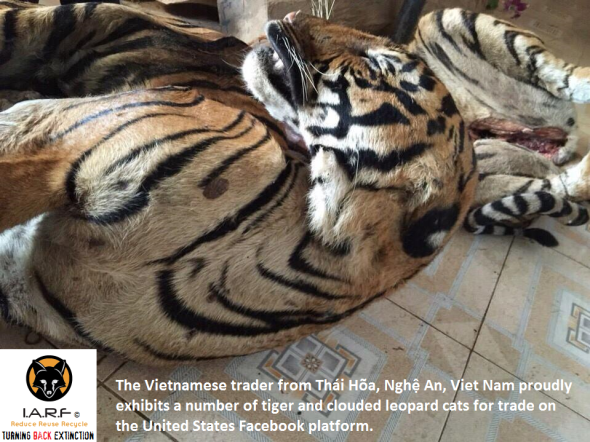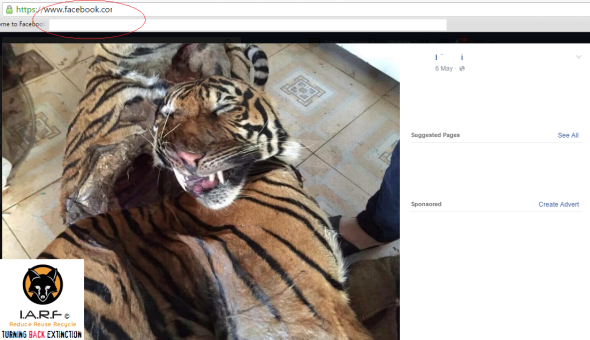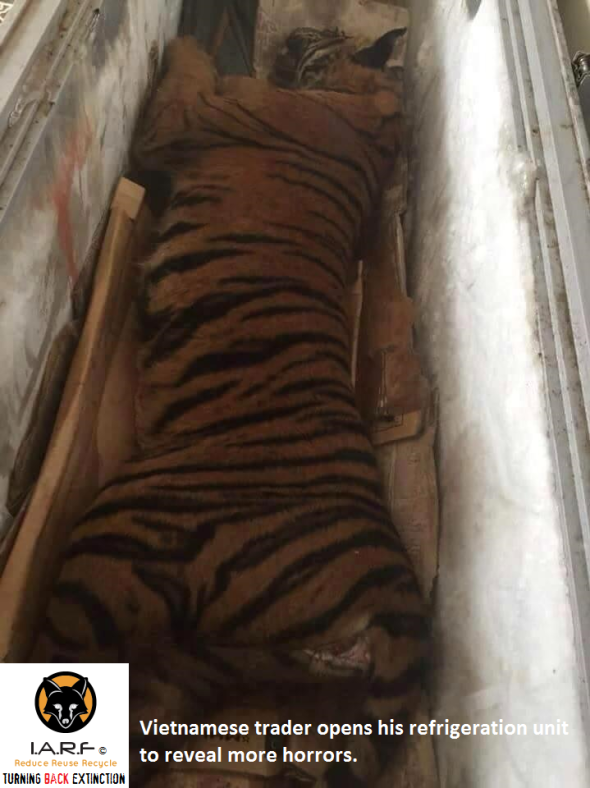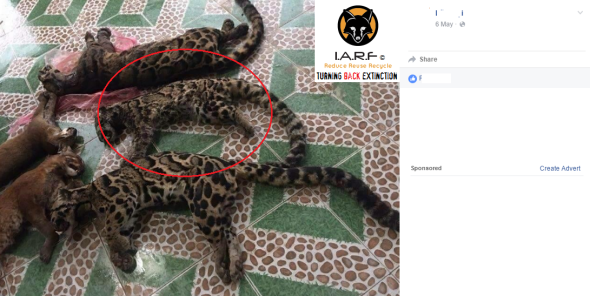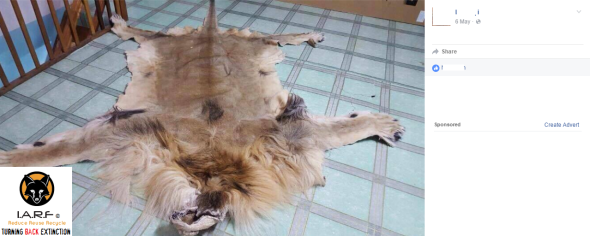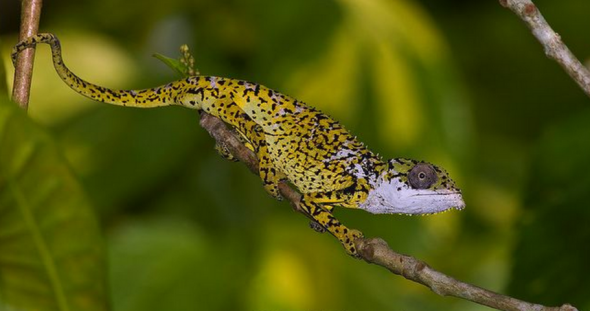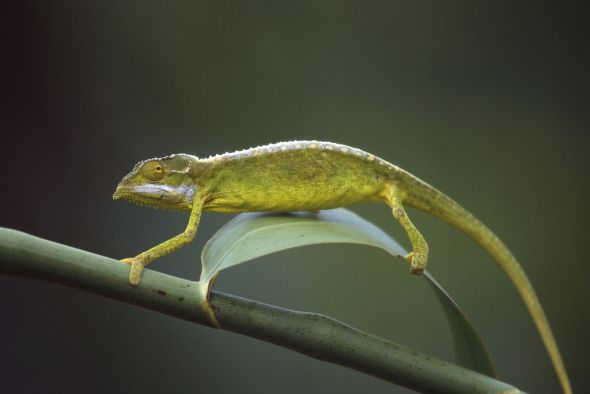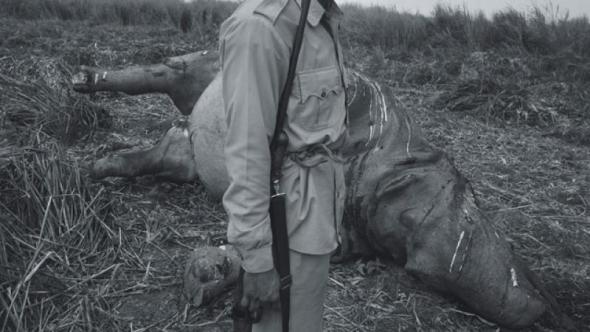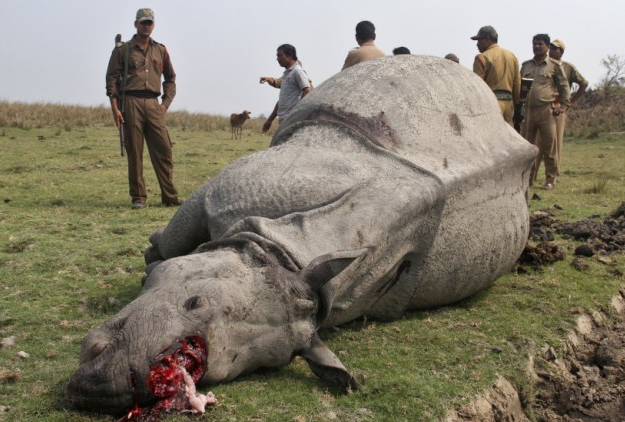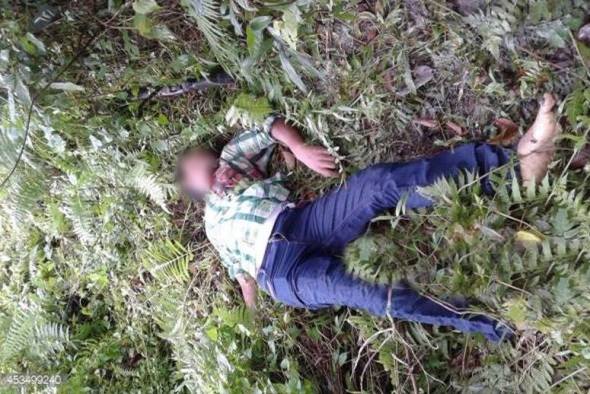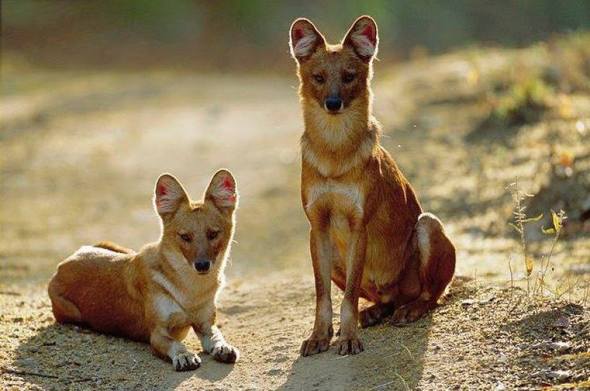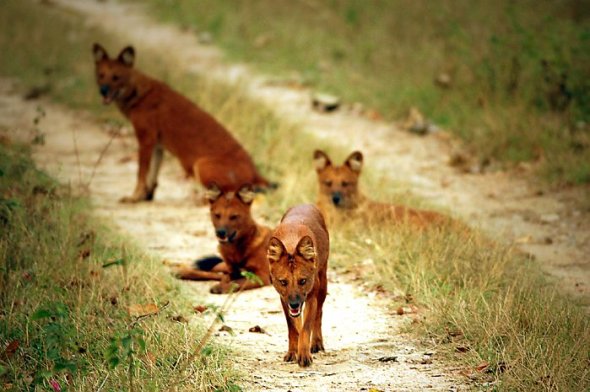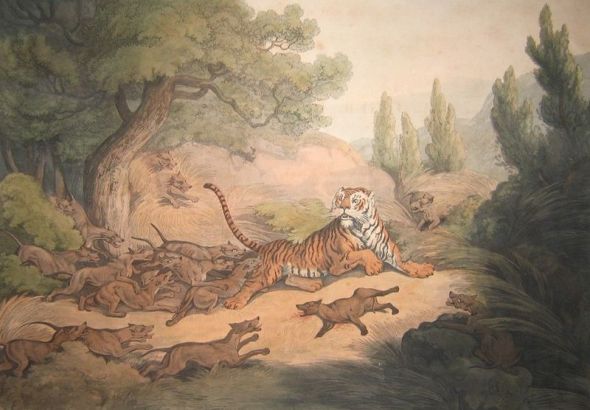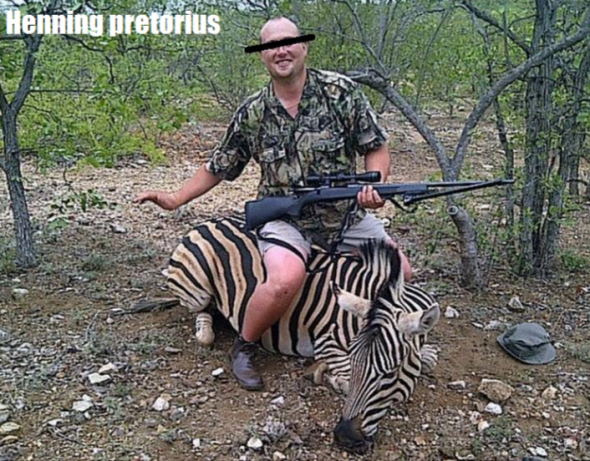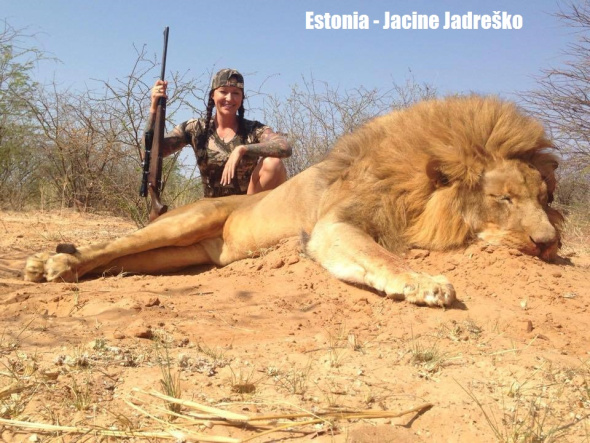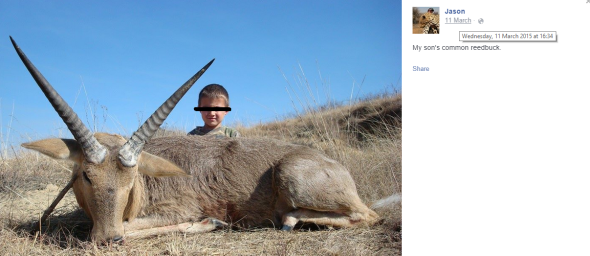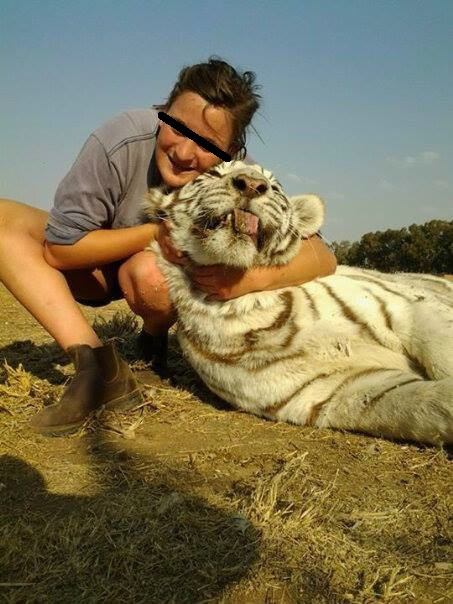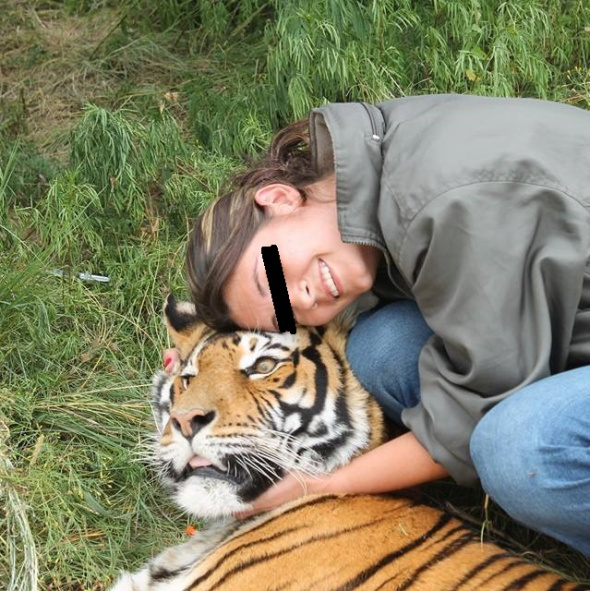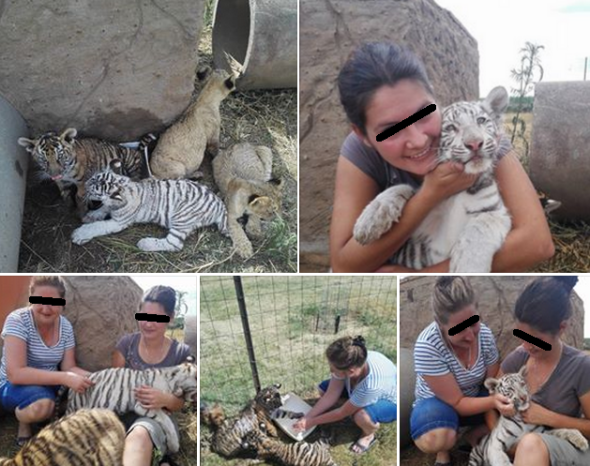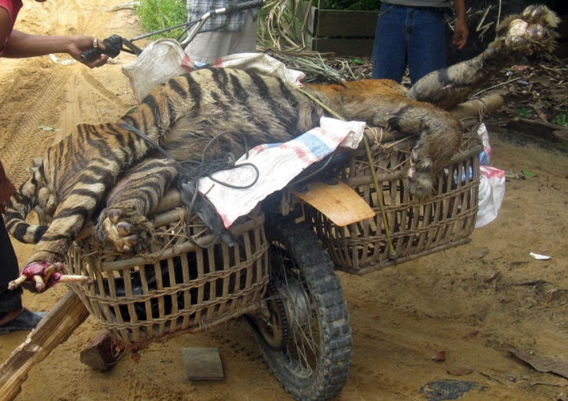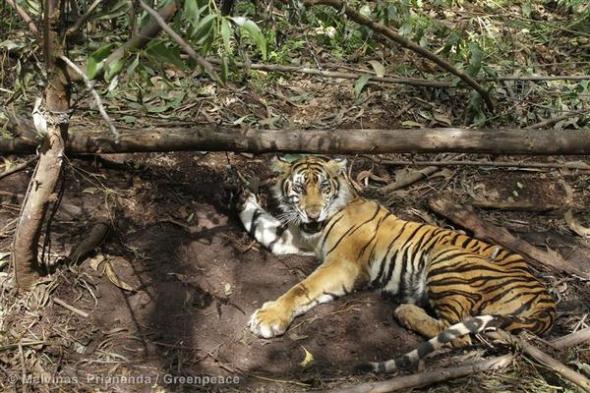FACEBOOK: TIGER PARTS TRADE | HORROR IN VIET NAM | PART II
TIGER TRADE | VIET NAM
The images your about to view in this article have all originated from an ongoing investigation into the illicit animal parts trade online and on the ground in South East Asia. My name is Dr Jose C. Depre, for some five years now my environmental and animal crimes investigation company has continued to delve deeper and deeper into the murky world of the illegal animals parts trade. (Image: IARFA Evidence image Tiger pelt, Thái Hõa, Nghệ An, Viet Nam)
Back in January of 2015 we began the forth phase of #OperationTrojanHorse focusing our attention mainly on Viet Nam, the operation that was launched is #OperationStopIt. Operation Stop It is fronted by numerous men and women from all over the globe that operate under myself the Chief Environmental Officer. We run two units that focus on ground level wildlife crime, and online wildlife crime. We’ve been investigating wildlife crime now since 2000 focusing on the bush meat trade, deforestation, chemical, and animal parts trade (among others).
Since June of 2015 when we began noticing a large number of traders dealing in tiger bone glue (alleged to be mostly fake), tiger claws and teeth, with various pelts and skulls. I then asked three wildlife trade investigators to work alongside me to dig deep into the murky world of the tiger parts trade. This area of the investigation focuses specifically on the ground and online trade of tiger parts. However we’re now looking into the online Facebook trade, an investigation that is uncovering “worrying evidence and corruption at governmental, police and zoo level”.
Its estimated (Cites and Traffic 2014) that there are some 6,100 “captive bred tigers” in Viet Nam, Laos, China and Thailand, furthermore since 1991-1993 the tiger trade has been officially banned within Viet Nam, unfortunately as one can see within the images herein, the trade still continues, although we “suspect these tigers are mostly captive”. Back in 1975 tigers were listed on Cites Appendix 1 (meaning that all trade in tigers domestically and internationally is now banned).
The problem we are currently finding within Viet Nam, as well as the loopholes within the current Cites laws, is that pretty much anyone in Viet Nam can apply for a permit to house tigers, so as long as them tigers are used for “conservation efforts only”. Cites laws do state that under no circumstances must any captive bred/reared tiger be killed or any part of any tiger used for trade.
However we must also remember that Cites is not a law agency, but more an organisation of parties from around the world that sets out laws; from there its down to that individual countries “policing agencies and that specific Cites department (in this case Cites Viet Nam)” to ensure laws are enforced. External Affairs Environmental Crimes Officers have though located numerous “corrupt Cites Viet Nam officers” of which I will be writing about soon.
As explained in (Article 1 - Facebook and the ivory trade); Facebook has become quite an easy platform for just about anyone to trade whatever they like (legally and illegally). Sadly in this case since June 2015 on-wards IARFA Environmental Crimes Officers have located staggering amounts of tigers and wildcat trade on the United States Facebook platform - all of which is 100% illegal, little of which from what we are locating is even under investigation from local and/or international trafficking and trade agencies.
The images below form part of a Vietnamese nation wide investigation that has uncovered corruption at Cites level, evidence that proves zoos are providing smugglers and traders with tiger and wild cat cubs and parts, and what we suspect is a legal trade of tigers from Africa into Viet Nam from which them tigers (bred in South Africa) “we suspect” are being used to fuel the massive tiger parts trade in Viet Nam. I will be documenting more on the “African connection later in the year”.
Image: Vietnamese trader calls posts freshly killed tigers with price. Buyer must collect.
The image at the top of this article depicting the tiger pelt rug is from the same individual in Thai Hoa, Nghe An, Viet Nam. He states in the Facebook posting “now ready to collect”. On viewing the messages underneath its quite clear that a price was already arranged privately within private Facebook messages, again no images of the traders face is available, nor any other identification as to what the name of this individual is. This is though normal, most traders operating illegally online or at ground go under various aliases, and rarely show their face, or use their real name. The trade is so secret locating tiger traders is actually considered rare, although once you uncover a large number of networks, follow them traces you do eventually locate numerous individuals trading in secret.
Image: Same trader, same tiger, all traded illegally on Facebook.
While Facebook has suggested they may be implementing new terms and applications to immediately ban such traders from their platform, we highly doubt whatever changes they do make will make any difference. For example users have the opportunity to create “secret Facebook buy and sell groups” or just “non-buy and sell Facebook groups”.
Once the group is set to private, only those within that group are able to report to Facebook or notify the police. So its a case of us then using our brains, technology and other applications to find these individuals. Once located all data is collected and then passed on. We don’t continue to monitor the groups or afterwards, as that is no longer our job. We’re not paid to police the web, or asked to. We do it though to help enforcement agencies, and to break the back of wildlife criminals.
We (the organisation) do highly suggest that you notify ourselves or the local police before Facebook so that evidence can be obtained before the account is “suspended” and not terminated. Once the account is suspended we, or any enforcement agency can then apply for a court order to seize any remaining evidence. Facebook hosts over 1.32 (billion) users and growing, so we find it highly unlikely any application implemented by Facebook is going to have much effect to those illegally trading animal parts. We’re talking about a platform that hosts 1% of the globes population! Hardly easy to police.
Image: Tiger trader shows one of any carcasses to buyers, Viet Nam.
Viet Nam banned hunting of tigers back in the 1970’s; had they not banned hunting (aka poaching), all of Viet Nam’s tigers would now be extinct. Today there is a total of 30 Vietnamese critically endangered tigers remaining in the wild of Viet Nam that are literally on a life thread. So with hunting banned, and trade of tigers and their derivatives banned has it stopped the tiger trade? Unfortunately no, and its very unlikely we’ll see the trade stopped until everyone pulls together and works together to stop wildlife crime dead in its tracks, easier said than done though!
Image: Vietnamese trader opens freezer up to reveal more horrors.
Image: Asiatic leopard we “suspect has been removed from a zoo and killed”.
The image above does raise some concerns as to where exactly this individual obtained this Asiatic leopard from. Asian leopards are not common within Viet Nam, although they do allegedly exist (in the country which I highly doubt). This is the first time we’ve come across an Asian leopard of which are considered “extremely rare” within Asia. We do suspect that the leopard may have originated from a nearby zoo, or the animal has been killed further east outside of Viet Nam, then smuggled into Viet Nam. The trader again states that the carcasses are ready to pick up, a price has obviously been made within a private communication which we can see in the comments section. This leopard may have originated from South Africa as a cub, if proven to be true it yet again blows a large hole in the so called “petting and breeding trade in South Africa”.
Image: Poached clouded leopards for sale on Facebook in Viet Nam.
IARFA Environmental Wildlife Crime Officers have been locating a large number of clouded leopard cubs for sale on Facebook. Most of which are dead, or normally its the skins that are traded. Both species in the genera of clouded leopards are considered “threatened” and nearing extinction within a number of Asian countries. Its unsure what these small cats will be used for, however back in December 2015 we located smaller tiger and leopard cubs that were being mixed with whole Asian and African pangolins. They were placed into what we now know was a type of Asian marinade, prepared and cooked some days later.
Image: Young tiger cub, seems to have been rolled up into bag then transported.
The evidence above was located by Environmental Cyber Crimes Officers from the IARFA. This particular trader has shot up on our radar because he has direct connections to (an unidentified South African game breeder and hunter). The Viet Nam citizen that we cannot name for enforcement reasons only recently visited South Africa to hunt a lion. Furthermore not only did the individual bring back with him a lion skin (pictured below), he also flew back from South Africa with a large number of lion bones. Again why was he allowed to leave South Africa with them bones for, and how on earth did he smuggle them out of South Africa, which its believed not to be a criminal activity.
Image: The Vietnamese trader recently visited South Africa to hunt a lion.
Image: Same trader found trading pangolin scales in the same secret Facebook group in Viet Nam.
IARFA Environmental Crimes Officers have been following this traders movements for some weeks now, although this week was when we eventually located yet more evidence of his seedy criminal network involving big cats. The Facebook group that specializes specifically in trading “tiger parts” also trades a very large number of tiger claws, tiger teeth, tiger skulls, tiger testicles, and tiger pelts. The image below depicts what were up against.
Image: Secret Facebook buy and sell groups protect Asian traders (so they believe).
The image above is just one of five images out of a staggering 14,562 images all depicting tiger traders, bear part traders, rhino horn and ivory traders and finally pangolin traders. In total there is just in this group alone a staggering 8,000+ individuals ranging mostly from Viet Nam, South Korea, China, Thailand and Laos. The Facebook group was established some 2-3 years ago from what we have seen.
Furthermore while we’d really love to report this group and have it shut down, its not that simple. Within this group alone contains evidence of wildlife trade that spans the globe from Asia to Africa, and Europe to America. One user only has to log into this group of which they are then in touch with a highly active, and sophisticated network of traders operating locally and internationally. Now do you see what we’re up against? I the CEO have long suspected since early 2006 that trade patterns were either changing, or poaching was indeed decreasing to some levels. On my travels to South East Asia I had noticed that there were fewer and fewer traders operating on ground level.
Yet poaching rates of tigers, elephants, pangolins Etc was still increasing with some reports of poaching decreasing. Many NGO’s pointed out they were winning the war on poaching, yet couldn’t explain why populations of many “trade animals” were not increasing within their endemic wild. Well here is just a small snippet of that change in trade patterns, poaching is most certainly still ongoing, and increasing, trade is still increasing furthermore - and under no circumstances are we winning the war on poaching locally and internationally. Why? We’re not winning it because technology has mostly played a pivotal role in now concealing trades and traders I.e online.
To date we have located exactly 203 active illegal wildlife groups online (in Viet Nam alone), some of them groups have direct connections to what was once “large wildlife trade markets at ground level”, in a sense what were seeing here is alike to the change in industrial markets in the west. They (the traders) now find it more easier and cheaper to trade goods online, and this is what we are seeing in Asia, with very little in the way of enforcement or monitoring. Facebook has become the new hotbed wildlife trade market place, its big and growing by the week. Furthermore most of these traders are using fake names, and code words to conceal their tracks and trade.
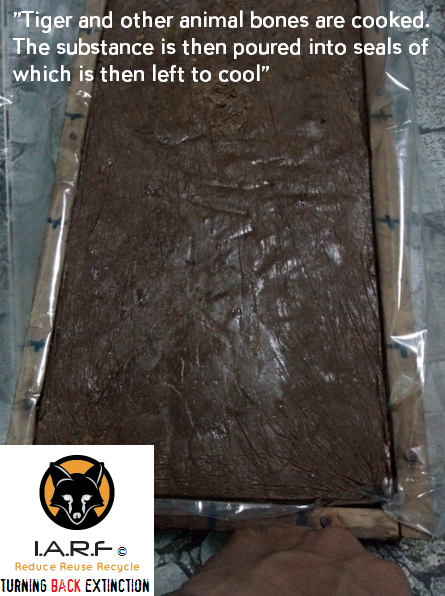
Image: Tiger bone glue, please click on the link in the image for information.
Tiger bone glue was said to be the most expensive wildlife product on the black market. Mixed with a wide number of synthetic drugs to cure so called illnesses and to act as a narcotic, environmentalists did state the glue is now mostly fake and hard to obtain due to the decreasing tiger numbers in the wild. Unfortunately with so many tigers still being bred in captivity within Asia - tiger bone glue is still available, priced higher than rhino horn and ivory.
The tiger trade is unique when compared to the illegal trade of other wildlife in Viet Nam, due to the relative rarity and high value of the commodity. This often results in traders taking extra measures to assure secrecy in their dealings (although that is something to be seen on Facebook). Viet Nam’s illicit tiger trade is carried out by elaborate criminal networks that avoid detection through the use of disposable cell phones, connections across international borders, and using friends in high places to facilitate a smooth and steady flow of their product to the consumer.
Most tigers confiscated in Viet Nam originate from foreign sources, smuggled into Viet Nam from Laos and Thailand where major farming operations exist that both produce and launder animals from the wild. A number of key figures behind the tiger trade in Viet Nam have been identified but manage to avoid prosecution by distancing themselves from criminal activities or operating under protection of local officials. Prosecutions tend to target low-level figures involved in transport or brokering sales. Only a minute few of these prosecutions result in prison time for anyone involved. (Source ENV Viet Nam).
While we would like to believe that most tigers are originating from over the borders there is also as explained zoos that are not being monitored, are breeding tigers, then selling them tigers onto traders. Finally we also have what we suspect is a number of African petting and breeding farmers involved in this trade that continues to flout legal loopholes in the law.
The wildlife trade on Facebook must come to an end. Please sign the petition hereto:
http://www.thepetitionsite.com/645/521/701/facebook-remove-illegal-pet-and-wildlife-traders-from-your-server/
Thank you for reading.
Dr Jose C. Depre
Chief Environmental Officer.
Endangered Species Monday: Archaius tigris
Endangered Species Monday: Archaius tigris
This Mondays Endangered Species watch Post (ESP) I document on yet another African species of wildlife that hunting revenue is not helping to preserve. The Tiger Chameleon was identified back in 1820 by Dr Heinrich Kuhl (September 17, 1797 – September 14, 1821) was a German naturalist and zoologist. Kuhl was born in Hanau. He became assistant to Coenraad Jacob Temminck at the Leiden Rijksmuseum van Natuurlijke Historie. (Image: Credited to Henrick Bringsoe, A tigris).
In 1817 he published a monograph on bats, and in 1819 he published a survey of the parrots, Conspectus psittacorum. He also published the first monograph on the petrels, and a list of all the birds illustrated in Daubenton’s Planches Enluminées and with his friend Johan Coenraad van Hasselt (1797–1823) Beiträge zur Zoologie und vergleichenden Anatomie (“Contributions to Zoology and Comparative Anatomy”) that were published at Frankfurt-am-Main, 1820.
Commonly known as the Tiger Chameleon or Seychelles Tiger Chameleon the species is currently listed as [endangered] which is not uncommon as like many Chameleons within the Seychelles their range is shrinking by the year or being overrun by invasive botanical species.
Endemic to the Seychelles the species has been listed as endangered since 2006 of which populations trends are unknown. Much documentation often cites the species at “comparatively” low density, however one must not take this as factual until a true population count is seen. It has been alleged that for every [five hectares] there is possibly 2.07 individuals which isn’t good ‘if true’ since the island is only 455 km2.
From what we know the species remains undisturbed where there aren’t invasive Cinnamon trees identified as the Cinnamomum verum. However where C. verum is spreading the Tiger Chameleons habitat is under threat from this invasive plant. There is a negative correlation between Chameleon density and the presence of cinnamon, suggesting this invasion is detrimental to chameleon populations. Negative correlation is a relationship between two variables such that as the value of one variable increases, the other decreases.
The Tiger Chameleon’s main endemic range on the Seychelles islands is Mahé, Silhouette and Praslin. A historical record from Zanzibar (Tanzania) is erroneous. It occurs from sea level to 550 m asl, in areas of the islands that have either primary or secondary forest, or in the transformed landscape if there are trees and bushes present. Although they are currently estimated to have a restricted distribution on each island (following survey transects conducted by Dr Gerlach if anecdotal observations from transformed landscapes (e.g. degraded areas outside the areas surveyed) are valid, then the distribution would be larger than mapped at present.
To date the only [non-active] conservation actions that I am aware of are within the Vallee de Mai on Praslin which is currently not a protected national park. Fortunately the species is protected to some degree in the Morne Seychelles, Praslin and Silhouette National Parks. The primary threat within non-protected areas is as explained invasive Cinnamon which seems to be posing similar threats to both small reptilians, insects and birds on the islands and mainland Madagascar.
While the species has been in the past used as a trade animal it was alleged that there were no Cites quotes since 2000 - 2014. However from 1997 - 2013 a total of twelve live specimens were legally exported [despite the species threatened at risk status]. Cites allowed the twelve species to be exported for use within the pet trade which I myself find somewhat confusing. Two specimens were exported to Germany in 1981 with the remainder [10] sent to Spain. I am a little perplexed as to why these twelve specimens were legally exported, furthermore I have found no evidence or follow up data that would satisfy me in believing this export was even worthwhile for the species currently losing ground within their natural habitat.
From 1981 -2010 a further 98 dead specimens were legally exported for scientific zoological projects. Then in 1982 a single live specimen was legally exported with Cites permit for experimental purposes. While I cannot [again] locate any evidence or reason as to why this single specimen was exported alive - I must make it clear that Cites is sympathetic to Huntington Life Science’s and various other animal experimental laboratories. However this doesn’t prove that Cites has exported to anyone of these experimental research centers, it is merely my assumption.
Image: Archaius tigris
No other trade is reported out of the Seychelles, although re-export of specimens imported to Germany and Spain has been reported to Switzerland and South Africa, respectively (UNEP-WCMC 2014). This species is present and available in limited quantities in the European pet trade, and illegal trade and/or harvest may occur on a limited basis. ‘A’ report handed to myself from an [anonymous 2014] officer from the office of UNEP states that a population of some 2,000 specimens has been recorded [2014] however there is yet again no census historical data to back these claims/report up. I again must point out that if its proven there are no fewer than [2,000 Tiger Chameleons] remaining in the wild and, Cites is allowing export then Cites is going to come under immense pressure from International Animal Rescue Foundation Africa because exporting live animals for pet trade at such ‘alleged’ depressed populations - is neither helping the species nor supportive of conservation practices.
Threats
The main threat is habitat degradation as a result of the invasion by alien plants species, especially Cinnamomum verum, principally on Mahé and Praslin. Cinnamon is displacing other vegetation, it is present all over the islands and it is the fastest growing, heaviest seeding plant in most areas and is changing the composition of the forests. Currently it makes up 70-90% of trees in Seychelles forests, reaching >95% in some areas. For Archaius tigris, the cinnamon trees provide a normal structure of vegetation, but the invaded forests support a massively diminished insect population, somewhere in the region of 1% of normal abundance. This excludes invasive ants which are the only common invertebrates associated with cinnamon.
In addition, the cinnamon produces a denser canopy than native trees, giving deeper shade which excludes forest floor undergrowth (other than cinnamon seedlings), and this also is a factor in the reduced insect abundance. The Chameleons are found on cinnamon and in cinnamon invaded areas, as long as there is a wide diversity of other plants and a dense undergrowth. In fact, rural gardens can provide habitat for the Chameleons, because these tend to be more diversity in terms of flora, and therefore can support invertebrate fauna.
Dr Jose C. Depre
Environmental and Botanical Scientist.
India: War on Poaching Intensifies.
India: War on Poaching intensifies.
Since early May 2012 the Indian State, Maharashtra government provided all of its rangers a shoot to kill licence directly aimed at “poachers” regardless of age, sex or religion. The shoot to kill order was given of which rangers are immune from prosecution due to high levels of Rhino, Tiger, Lion and, Elephant poaching within the country.
When International Animal Rescue Foundation India became aware of Maharashtra government’s demands they watched and waited for results of which back then were little however, since 2013 rangers have been actively involved in over one hundred and forty nine legal killings with a further eleven so far to date (13th June 2015). The number is believed to be a lot higher. Furthermore as poaching is not just confined to “animals” but also the sacred sandalwood, forestry rangers have been actively engaging sandalwood poachers and smugglers too.
April 4th 2015 forestry rangers and Police came under heavy gunfire in two separate locations within Tamil Nadu, Chittoor. Police and forestry guards tried to apprehend some twenty sandalwood poachers/smugglers of which took off into the sandalwood forests in Andhra Pradesh. The first shoot out saw some saw some nine smugglers shot dead in one area of the sandalwood forest that is unknown to us while a second saw a further eleven smugglers shot dead in what was described as a “heavy exchange” of bullets from both sides within Chittoor in Southern Andhra Pradesh. While some people have stated this action unjust we please ask you to continue to reading (to the bottom) for you to fully understand why the Police and forestry services may have took such action.
2015 has been quite a busy year thus far for forestry rangers and Police. At the start of the year, 15th January 2015 three Rhino poachers that were directly ordered to lay down their weapons aimed them at forestry guards opening fire. The incident that took place in the Kaziranga National Park, in the remote state of Assam prompted forestry guards to act quickly and professionally to preserve the sacred One Horned Rhino of which they shot the three poachers dead instantly. Fortunately no forestry guards or the Rhino were injured this time.
March 2015 a further three ivory poachers that were caught red handed slaughtering an Indian Rhino of which the Indian Rhino lost its life and was left in a pitiful state were shot dead immediately. We’ve included the image of that Rhino below for your information and to grasp why we and India have now had enough of this slaughter and will take the relevant steps required to support our men and women to secure our fauna and flora.
Image: Rhino killed by ivory poachers - poachers shot dead on site.
While poaching continues so does “hunting the poachers too” and so it rightfully should. International Animal Rescue Foundation India supported by its sister Africans Environmental company, began paying five “unnamed” forestry units within the shoot to kill zones larger cash incentives to hunt and take down any mammal or sandalwood poachers. The organisation has come under some fierce criticism from mainly European and American citizens most of which are devout church goers or, believe poverty is the first step that needs to be dealt with.
International Animal Rescue Foundation’s Indian Chief Executive Officer Vasvi Kanal stated “On consulting the Chief Environmental Officer back in 2012 when we were made aware of Maharashtra’s stance we knew we had to do something to support our brave men and women. After a meeting in New Delhi that following summer it was decided we should support the shoot to kill policy to send a a direct message out to poachers that you’ll no longer simply walk into our forests and parks and take what’s not rightfully yours”. Kanal went onto state “The shoot to kill policy had to be endorsed one way or the other and, I thank the Chief Environmental Officer Dr Jose Depre for wiring the funds directly to us that are now placed into the hands of these brave men and women to seek and kill poachers”.
Image: Indian Rhino poacher shot dead on site.
Since the policy was enacted in 2012 in Maharashtra some seven states within India have since followed suite of Maharashtra’s firm stance and, since 2014 we’ve seen a staggering increase of poachers that have been caught trying to kill Rhino, Elephant, Tiger or illegally harvesting sandalwood shot dead on site. Furthermore many Indian press agencies have picked up the organisations support creating debate and stories on the subject that has encouraged more and more female and male citizens to come on board to protect and preserve our natural habitat and sacred heritage.
Soon after Maharashtra’s stance on “all animal and habitat poaching/destruction” took on a new positive twist, Nepal back in 2013 set their Anti Poaching Units into action - to hunt the - hunters. About 10 years ago, when the country was deeply mired in a civil war between government forces and Maoist rebels, there was hardly any focus on wildlife protection in one of Nepal’s most famous parks
The number of army monitoring posts in and around the park was reduced from 30 to seven as soldiers were shifted to anti-insurgency operations. In 2002, about 37 Rhinos were killed by poachers, triggering grave concern over the future of One-Horned Rhinos. Their numbers dropped from an estimated 612 in 2000 to less than 375 in 2005.
“According to our last rhino census in 2011 the number of Rhinos in the park has risen to more than 500,” said Kamal Jung Kunwar, a senior official at the Department of National Parks and Wildlife Conservation.
As the chief of the Anti-Poaching Operation from 2003 to 2007, Mr Kunwar played a key role in the conservation of Rhinos in Chitwan National Park. Spread over an area of more than 930 sq km, the park consists mostly of Sal trees and grasslands. Its flat lowlands are home to a variety of endangered animals like Royal Bengal Tigers, Rhinos, Leopards and Gharial Crocodiles. Crucial re-deployment: The successful conservation effort is attributed to a variety of initiatives, including tough action against poachers, enhanced intelligence and involving villagers living around the park in conservation efforts.
Image: Rhino poacher shot dead.
Meanwhile, while India strides forwards in its tough Anti Poaching operations poachers are still targeting rangers and police leaving their seriously injured on in many cases themselves killed. Deaths continue on both sides and rarely do the press and media overseas bother to print on the bravery of these men and women or, their tragic deaths.
Back in January 2014 poachers killed a female Rhino and a home guard at the Rajiv Gandhi Orang National Park, that Wednesday. Park officials said the home guard, Sushil, was killed during a gun battle with the poachers, who also managed to chop off the Rhino’s horn.
Rifles and ammunition were recovered from the spot. This is the second case of poaching at Orang which has about 100 Rhinos. The last Rhino was killed earlier in December, following which the park authorities announced a cash reward of Rs 50,000 for information on poacher Md Joynaluddin alias Junu. The authorities have also pasted Joynaluddin’s posters at several places in Darrang, Sonitpur, and Morigaon districts.
Back in 2014 a survey was undertaken on the number of rangers that are sadly murdered by poachers and killed by wild animals within the country according to the IBT. The results were shocking of which encouraged International Animal Rescue Foundation India to push more funding into local forestry units around Assam and the Ministry that supports guards financially. India loses more forest/Anti Poaching Guards than any other country on the planet.
Most of the Indian forest security men and women have been killed by poachers and wild animals, states the survey by non-profit organisation International Ranger Federation (IRF). In the past three years, as many as 72 forest rangers died in India, whereas in other countries in Asia, Africa and America, only less than 10 deaths of forest rangers have been reported, The Times of India reported, quoting the survey by IRF which strives to create awareness about forest rangers and security men.
It can be recalled that smugglers of red sanders killed several forest rangers in AP’s Tirumala forests in recent years. Notorious bandit Veerappan has also killed several forest officers and security men till a decade ago. The survey further stated that about 60 percent of the forest rangers’ killings, in the last three years, happened in Asia.
“We are extremely concerned that rangers continue to face high levels of violence and are being murdered at an alarming pace,” said IRF president Sean Willmore.
India lost 24 forest rangers in 2014, 14 in 2013 and 34 in 2012. India tops the list in the deaths of forest rangers during all three years. The report went onto state - That most rangers were killed by wild animals and poachers. Apart from animals and poachers, diseases such as dengue and malaria, forest fires and road accidents have also claimed the lives of rangers, the survey added.
In India, smugglers of wild animals and forest wealth like red sanders do not hesitate to kill rangers, if they are obstructed from committing the crime. In Seshachalam forest of Andhra Pradesh, about 200 smugglers attacked forest rangers and killed two officers in December 2013. The 200 smugglers first rained stones on the ranger sand then attacked them with batons. Rangers in India are often seen unarmed, making them vulnerable to the smugglers’ attacks.
The government of India has been dealing with wildlife poachers with an iron fist in the past one year with 30 poachers being gunned down in the Northeast alone. The number that figured in the data released by the environment ministry is the highest ever in the country. Most of the killings took place in the Kaziranga National Park, Assam. The KNP, Assam is the largest known “active poaching area” hence the largest amount of hits and is custodian to over 1000 endangered Indian one Horned Rhinos.
“The number shows our determination to eliminate wildlife traffickers and poachers. It is a big achievement of the Modi government,” environment minister Prakash Javadekar said recently.
Highly sophisticated arms were recovered from the poachers who killed Rhinos for horns smuggled to South-East Asia through porous Myanmar. Hunting down of poachers in Kharbi Anglong of Assam was undertaken by the Congress-led Assam government to save single-horn rhinos of Kaziranga and nearby areas.
Big cats at huge risk:
Wildlife in other parts of the country isn’t as lucky as the Rhinos. As many as 23 Tigers and 116 Leopards were poached in 2014 across India, with states like Uttarakhand, Maharashtra and Madhya Pradesh reporting a large number of cases.
“These are the cases that have been reported. There might have been cases where the poachers took the whole animal, without leaving a trace,” said Tito Joseph of the Wildlife Protection Society of India. Traffic, a non-government group monitoring wildlife trade, says that there has been no let down in illegal wildlife trade in India. It says the Northeast is turning into a hub of wildlife smuggling.
A report by the National Tiger Conservation Authority also indicates weak wildlife crime management in the country. It states that almost 40% of the forest guards do not have enough equipment to deal with highly organised wildlife crimes. “The states are not providing funds to modernize wildlife crime management,” a senior official said.
Concluding;
Despite some public criticism calling the organisation “dogs” and “disgusting” India’s tough stance on Anti Poaching must continue. International Animal Rescue Foundation India hopes to push a further $15,500 into the cash incentive jar to help equip rangers, police and forest guards. Furthermore the environmental company that has some one people working on the ground in New Delhi will be working with local communities in poverty stricken zones where poachers are known to originate from to help decrease poaching, improve poverty and hopefully decrease killing on both sides.
Lastly I wish to leave you with this video directed at those that believe Indian forestry guards and Anti Poaching Units are randomly picking off innocent people. Please watch the video to the end and undertake your own Google search on those brave men that sadly lost their lives fighting for animal and environmental freedom.
Thank you for reading.
Johan La Roux
Rhino Welfare Project Africa.
Endangered Species Monday: Cuon alpinus.
Endangered Species Monday - Cuon alpinus.
Dhole - Reckless and Daring.
This Monday’s endangered species article we focus on a rather undocumented species of wild dog in the family of canidae generically identified as the Cuon alpinus back in 1811 and commonly named as Asiatic wild dog, Indian wild dog or just Red dog.
The species was scientifically named by Berlin born Dr Peter Simon Pallas (22 September 1741 – 8 September 1811) was a German zoologist and botanist who worked in Russia. A number of animals were described by Pallas, and his surname is included in their common names, including: Pallas’s cat, Pallas’s long-tongued bat, Pallas’s tube-nosed bat, Pallas’s squirrel, Pallas’s leaf warbler, Pallas’s cormorant, Pallas’s fish-eagle, Pallas’s gull, Pallas’s sandgrouse, Pallas’s rosefinch, and Pallas’s grasshopper warbler. Also, he is honored in the specific epithet of scientific names of animals described by others, including: Pallas’s pika (Ochotona pallasi), Pallas’s reed bunting (Emberiza pallasi), and Pacific herring (Clupea pallasii). (Wiki).
The Dhole is currently listed as (endangered) of which its populations are still decreasing quite rampantly. Although declines are still being documented the species remains native to Bangladesh, Bhutan, Cambodia, China, India, Indonesia, Kazakhstan, Kyrgyzstan, Lao People’s Democratic Republic, Malaysia, Mongolia, Myanmar, Nepal, Russian Federation, Tajikistan, Thailand and finally Viet Nam.
Within central eastern Asia there still remains no confirmed reports of Dhole populations of which the species was once endemic to this range. However as the species has yet to be declared extinct within countries of eastern Asia we must continue to make public that the species may still be true to this region of south east Asia. Recent reports have stated the species was seen within Jiangxi district, south China, however, outside of this area no other confirmed sightings have been noted now for some years within the Tian-Shan Range.
Few sketchy reports have vaguely confirmed that the species was seen (2006) Qilian Shan in north-western Gansu Province. Meanwhile the Dhole still remains within Tibet of which forestry officers and locals confirm the species as “commonly viewed” which is at least a positive note despite populations declines over much of the species endemic range. North Korea was once known to hold Dholes however due to the communist states strict rules and no-go-areas its difficult to document or research on the species. If North Korea does indeed hold Dholes environmental research teams must be granted entry to secure the species from any localized extinction occurring.
South of the River Ganges, India Dholes are still very commonly viewed despite large human population increases, species displacement, human species conflict and, habitat fragmentation. Central, eastern and western India Dholes are still known to inhabit again, commonly. Research teams continue to pick the species up within north eastern India in the states of Arunachal Pradesh, Assam, Meghalaya, and West Bengal too. Further reports place the species within the Ladakh area of Kashmir, which is contiguous with the Tibetan highlands in China.
In Bhutan, there have been recent press reports that Dholes have recovered from a government-initiated mass poisoning campaign in the 1970s and there have apparently been numerous recent incidents of Dholes killing livestock in the lower Kheng region. Two recent, independent, eye-witness reports identify Dholes in six protected areas in Bhutan. In some regions, Dhole predation on wild boar (Sus scrofa) may be viewed in a positive light by local people. Wild boars are known to injure and in some cases fatally wound the locals.
Reports still cannot confirm if the species is present within Bangladesh. In Indochina, Dholes probably ranged over all or almost all of Lao PDR, Cambodia, Viet Nam and Thailand, although reliable site-specific information is scarce. Present distribution is highly fragmented and large parts, particularly of Viet Nam and Thailand, are without any regular occurrence of Dholes, although they persist in a number of protected areas.
The species’ historical range probably included all or most of the Malaysian peninsula and the Indonesian islands of Sumatra and Java, but reliable information is scarce. Current distribution is poorly known but is thought to be highly fragmented. On the Malaysian peninsula, Dholes are known to occur in four sites in northern and central areas of the peninsula (from recent camera-trap surveys). On Java, Dholes appear to be most common in the protected areas at the eastern and western ends of the island. On Sumatra, very little is known, but Dholes are known to occur in major protected areas in the southern, central, and northern parts of the island (e.g., from camera trapping).. There is no reliable evidence of the presence of Dhole in Turkey.
Within some areas Dholes are known to inhabit the same areas as Tigers and Leopards however, due to increasing poaching attacks these areas are not being made public. Its quite likely though that poachers may use the Dhole as a point of interest to illegally monitor and poach Tigers and Leopards. Competition between the Dhole, Leopard and Tiger is mostly avoided due to differences in prey. Some reports have been duly noted of Dholes actually attacking Tigers causing them considerable damage and in two known cases Dhole packs have been documented as killing Tigers.
One would be led to believe that the Tiger has no real predators however, when a Dhole or Dhole pack confronts a Tiger the Tiger will on most occasions retreat up a tree or high rocky incline. Dholes are known to “mob” Tigers for a considerable time should they feel threatened or malnourished. Reports have shown that Dholes are more than able to fend off Tigers and in most cases will if threatened or in search of food maim or fatally wound the Tiger. Dholes are quite able to defend themselves too and have the canines to easily kill and take on Tigers in Tiger habitat. Interactions between the Dhole, Tiger and Leopard has been documented however very little eye accounts or video footage show such species species conflict.
One of the very earliest reports of “Indian wild dogs” attacking Tigers can be viewed below for your immediate attention and information.
Image: A Tiger Hunted by Wild Dogs (1807) by Samuel Howitt. This is one of the first illustrations of the species, featured in Thomas Williamson’s Oriental Field Sports. The depiction though is based on Williamson’s description of the animal as resembling the Indian pariah dog.
Threats
Depletion of prey base: Across almost all of Cambodia, Lao PDR, and Viet Nam, as well as within protected areas, ungulates occur at levels well below natural. All species of ungulate except muntjacs, pigs, and in some areas southern serow (Naemorhedus sumatraensis) are ecologically or fully extinct across extensive parts of the region. Only a few of the largest wildernesses support nearly intact species assemblages and even in these, the larger species (Bos spp., Cervus spp., hog deer Axis porcinus) are very rare.
This situation will likely hinder any possibility of recovery by the region’s Dhole populations, even if the other issues could be addressed. While not as depressed as in Indochina, prey levels in Indonesia also exist at levels much below carrying capacity (because of illegal hunting and habitat degradation). In protected areas in southern and central India, where Dhole numbers are stable, prey densities are high. In north-east India, prey densities are very low in protected areas with Dholes.
Habitat loss and transformation: Currently, extensive areas of natural or semi-natural vegetation remain in Lao PDR and Cambodia, some areas encompassing many hundreds of square kilometres of potential Dhole habitat. However, habitat conversion and fragmentation are proceeding apace. In Viet Nam, very few natural areas of over 50 km² remain. Habitat loss and fragmentation is a major threat to protected areas in Indonesia, particularly those on Sumatra. Habitat loss and degradation are also serious threats to Dholes in South Asia and the disappearance of Dholes from many of the forested tracts in India has been attributed in large part to loss of habitat.
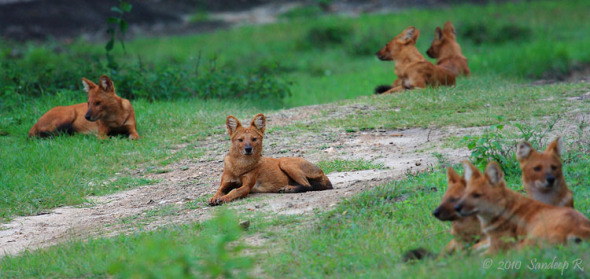
Persecution: This certainly occurs in Indochina, although it is unclear how often. In Indonesia, too, it is a threat but again its significance is unknown. In India, such persecution can play a serious role in limiting local populations. Dholes living outside or on the edge of core protected areas are particularly vulnerable to human kleptoparasitism, snaring (non-selective) and direct persecution. For example, during a radio-tracking study in 2000, in the buffer zone of Kanha Tiger Reserve, central India, at least 16 out of 24 Dholes in one pack died from a sudden strychnine poisoning. In southern India, such persecution is moderate to low and often occurs indirectly when cattle graziers and others inadvertently go close to Dhole dens and disturb adults and pups, disrupting breeding and rearing. “By-catch” in snares and other traps is probably a significant threat to Dholes across Indochina at least.
Competition with other species: Apparently, free-living dogs have been seen and/or camera trapped in many parts of Indochina, but there is no evidence for existence of large populations. Undoubtedly, the main competitor for prey species in Indochina is people. There is no evidence that feral dogs are significant competitors with Dholes in Indonesia. In many parts of their range, Dholes are sympatric with Tigers and Leopards and so the potential for significant interspecific competition for prey exists, especially if the prey populations are reduced as a result of hunting by people.
Disease and pathogens: Particularly those transmitted by feral and/or domestic dogs (e.g., mange, canine distemper, parvovirus and rabies). The significance of disease is unclear in Indochina, but diseases are a significant threat in South Asia and probably in parts of Indonesia. There is no widespread exploitation for fur or other purposes, though medicinal use should be investigated in China..
Thank you for reading.
Dr Jose C. Depre
Chief Environmental and Botanical Environmentalist (CEO)
info@international-animalrescue-foundation.org.uk
www.speakupforthevoiceless.org
www.saynotodogmeat.net
www.saynotodogmeatevents.info
www.international-animalrescue-foundation.org.uk
Con in Conservation?
Contrary to popular belief native Africans were not the first people on the continent to pursue a career or “sport” of trophy hunting. The history of trophy hunting dates as far back to the early 1800’s when southern and central European hunters sought out large or small game. Not much has really changed since the early 1800’s although hunters did out of mutual respect show much veneration to their kill more than today’s modern hunters that flock to the continent of Africa from far and wide in their droves.
Southern and central European hunters were known to keep the trophy head or entire animal as a sign of prowess however did leave much waste of which little of that waste was provided to local villagers and communities struggling financially or in times of famine when free food was much sough after. Today most professional hunters (PH) or outfitters allege that their trophy kill’s are evenly distributed out to the local communities and villagers in dire need of food.
Today in most of Southern Africa we see a mixture of international citizens hunting animals from lion, elephant, zebra, cheetah, impala down to hippopotamus and plains game. The vast majority of hunters visiting the continent range from northern Europe where hunting has long been associated with their history. Back in the 1800’s northern European hunters within their native range would mostly hunt for meat and in Africa evidence has shown that the majority of northern European hunters do indeed demand their kill or any waste is equally handed out to local villagers and communities. After all its their tradition and a tradition in northern Europe that is steeped in history.
Sport hunting has long gotten up Animal Rights Activists noses which today’s hunting generation rarely follow any rule of the land or continue to practice the family tradition as if its a heirloom. Environmental researchers from the Environmental News and Media team have long argued now that western disrespect within today’s hunting generation is now rubbing off onto our own African citizens that have been witnessed killing animals then parading the parts of bodies of animals or jokingly fooling around with the corpse as if it was nothing more than a piece of shit on ones shoe.
One such hunter witnessed back in 2012 that our investigative team noted last year named as Mr Henning Pretorius from Krugersdorp Gauteng, South Africa didn’t just grotesquely slaughter this non-threatened Zebra below - he then set about jumping on the animals dead back jokingly fooling around and acting as if he was on some rodeo. Hardly professional hunting nor conservation. We will though give him his due respects where given of which the animal was slaughtered - however made into a rug for his own home. The meat was distributed among family members and friends which back in the 1880’s was uncommon.
Since Henning pretorius became aware of this image circulating Mr Pretorius not only demanded its removal but, has been given special cyber protection - I.e his profile has been blocked from the United Kingdom. We do find this move by Facebook rather peculiar as 1. we’re not British citizens or even residents and 2. why has he been given this rather suspicious preferential treatment? Did we touch a sore nerve. Mr Henning has also taken the rather unusual step of removing this image or at least concealing it amidst his other nauseating images that Facebook’s administration platform seems to be protecting.
Kalahri’s Historian on hunting and Animal Rights stated:
Trophy hunting is the most controversial aspect of hunting for opponents of hunting, who argue that modern economics or vegetarianism should eliminate the need for most killing of animals, if not animal domestication entirely.
They see such killing as an issue of morality, citing British fox hunting as an especially inhumane “blood sport.”
Hunting in North America in the 1800s was done primarily as a way to supplement food supplies. The safari method of hunting was a development of sport hunting that saw elaborate travel in Africa, India and other places in pursuit of trophies. In modern times, trophy hunting persists, but is frowned upon by some when it involves rare or endangered species of animal. Other people also object to trophy hunting in general because it is seen as a senseless act of killing another living thing for recreation, rather than food.
In all due respects Henning and Kalahari are nothing more than a CON in Conservation.
Africa holds the largest custodian of lions in the world. However their populations are dwindling quite rapidly. To date and based on the most recent up to date International Union for the Conservation of Natures report a population count of some 30,000 lions remain in the wild. Listed as vulnerable and nearing endangered they remain the second species within the big five that’s populations are actually declining. Central African elephant “populations” could be considered within this count too however based on census reports elephant populations within the central African republic are known to be “endangered” as a population not as an entire species.
The African lions main threat is that of habitat destruction and human species conflict with some reports of “unregulated hunting” as being problematic mostly within Tanzania. However while the IUCN lists certain dangers regarding the lion such as habitat destruction, persecution and unregulated hunting they fail to list the dramatic decrease of male African lions that are required within the prides to keep species intact. Continued hunting of males lion or even female lionesses will eventually have an adverse effect onto lion populations thus pushing this species into the realms of endangerment.
Environmental News and Media has duly noted from 2011 to 2014 a stark increase of eastern and southern European hunters visiting Africa to hunt the big five. Increases from Ukraine, Russia, Czech Republic, Poland, Romania, Slovakia, Serbia, Bosnia and Turkey have been noted. More worrying are increasing numbers of trophy hunters such as Jacine Jadreško from Croatia (pictured below).
Croatian, Albanian, Russian, Czech Republic and Polish trophy hunters are second to that of American hunters with British hunters slowly creeping up. While sport hunting is not currently considered a major threat to the species, habitat loss, a lack of prey and increasing conflict with humans are to blame for the decline in the numbers of African lions, whose numbers have dropped by two-thirds since the 1980s, according to 2014 USDA report. There were 76,000 lions in Africa in 1980, but that number has declined to about 30,000 today.
Zambia has since lifted the ban on hunting lions and cheetahs. The ban wasn’t lifted because lion and cheetah species populations began increasing but more for sustainable wildlife projects. In other words while the ban on hunting was in place funding to secure wildlife from poaching just didn’t hit the target - so - therefore Zambia has limited the ban to generate funding to preserve its natural wildlife.
A Con or practical thinking?
Environmental News and Media’s External Affairs Investigations Dept noted a stark and worrying increase of youth hunters to the continent too. Most African countries hold certain rules in place the forbid a minor under the age of sixteen from carrying or even shooting a loaded rifle. As one can see in the case below this is not so. From Howick, Kwazulu-Natal laws are being flouted daily.
Con or gun conservation?
A further worrying trend were witnessing in South Africa are tiger farms springing up everywhere in the Eastern Cape - for the gun. From 2012 to 2014 Environmental News and Media recorded a total of 63 tiger farms in the Eastern Cape. Since 2012 a further 21 have been established. Tigers are listed as critically endangered - yet are bred and for the gun.
One of the world’s largest and most iconic predators may soon go extinct in the wild - yet in South Africa the species are being bred for for the bloody gun!
Amid all the fuss over global warming and alternative energy, the continued loss of biodiversity is being largely overlooked and forgotten. And the trend may claim its highest profile victim to date in just a couple decades, say conservation groups. For at least a million years tigers have roamed the forests and jungles of Asia, ruling the top of the food chain. But today Tigers are facing a final bow from the world they once ruled as their habitats have been destroyed and their numbers slashed by poaching.
At the start of the twentieth century there were an estimated 100,000 tigers. Over the course of the last century those numbers shrank and several subspecies — the Bali, Javan, and Caspian Tigers — went extinct.
The WWF has released a new report estimating that there are now only 3,200 tigers left in the wild in India, Southeast Asia, Russia, and China. They estimate that within a generation tigers will become extinct in the wild, if drastic action is not taken to conserve them.
Sybille Klenzendorf, director of the WWF-US species conservation program comments, “There is a real threat of losing this magnificent animal forever in our lifetime. This would be like losing the stars in the sky. Three tiger subspecies have gone extinct, and another, the South China tiger, has not been seen in the wild in 25 years.”
World Bank, a multinational financial institution that provides loans to developing countries, is partnering with the WWF in a push to save the beasts.
Keshav S. Varma, program director of the World Bank’s Global Tiger Initiative comments, “Unless we really crack down on illegal trade and poachers, tigers in the wild have very little chance. If the tigers disappear, it is an indication of a comprehensive failure. It’s not just about tigers. If you save the tiger, you are going to save other species. It provides an excellent indicator of commitment to biodiversity. If they survive, it shows we are doing our job right. If they disappear, it shows we are just talking.”
Despite the fact that so few tigers remain, demand for their body parts is at an all time high on the Asian black markets. Crawford Allan, director of TRAFFIC-North America, which monitors the trade in wildlife, comments, “The demand for bones and skin, meat, and even claws and teeth … is driving a major crime campaign to wipe tigers out in the wild.”
Lixin Huang, president of the American College of Traditional Chinese Medicine has teamed with the WWF to try to fight Chinese natives from using tiger parts in their traditional remedies. States Huang, “Traditional Chinese medicine does not need tiger bones to save lives. What we are dealing with is an old tradition, an old belief that tiger wine can make their bones stronger. That is not medicine, that is from old tradition.”
The WWF’s ambitious goal is to try to get the tiger population doubled to 6,400 tigers in the wild by 2022. To do that, they say they will need $13M USD a year and cooperation from the governments of Bangladesh, China, Europe, India, Indonesia, Nepal, Russia, the United States, Vietnam, and the Greater Mekong region, which stretches across Cambodia, China, Laos, Myanmar, Thailand and Vietnam.
Nearing extinction in the wild - Bred in captivity in South Africa for the gun.
Hardly Conservation is it?
Environmentalism chapter 5 - Tigers under threat
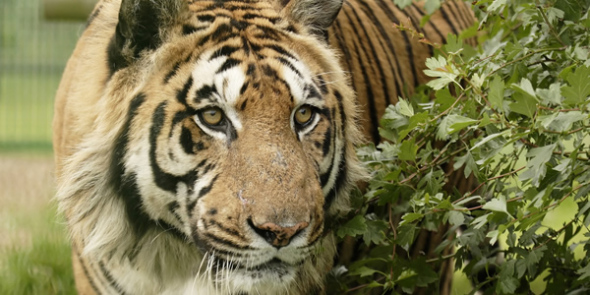
Bengal Tiger - Panthera tigris
The Tiger Panthera tigris the king of the jungle, a stunning species of “Tigers” that are now in serious need of preservation to keep it within the extant centuries to come and not the extinction era.
The Tiger species is the largest of all the big cat species standing at some 11-11.5 feet tall it’s regrettably the most endangered species out of all the wild cat species. Located mostly in east Asia, Russia, Turkey, Bali, India, it lives within large peat grass lands, dense forest and of course its natural areas in Asia where they are mostly located around and within the Ramin tree, (Gonystylus) areas of Indonesia and Malaysia although populated in India where poaching is rife.
With a total body length of just over three meters the Tiger species where wildly populated all over Asia, mainly in Indonesia, Malaysia, India, Japan, Russia and Belize however there numbers have plummeted to alarming levels. Now for 2013 they don’t even stand at 4,000
Bengals and Sumatrans are not the only species within the “Tigris” sub species that are at risk, the largest subspecies the Amur Siberian tiger Panthera tigris altaica is also critically endangered. There are roughly only 3,200 maximum Tigers left in the wild, that is a total in the last century gone of at least 98.5% of all Tiger species banished from the jungles of which they stalk their prey and rely mainly on sight and sound to hunt making them the most sleek predatory hunting cat that walks the earth. There declining numbers are primarily due to;
Tiger population decline;
- Habitual destruction
- Deforestation
- Palm oil and pulp and paper trade
- Human and species conflict
- Poaching
- Skin and fur trade
- Pollution
- Climate change
- Tropical pet trade
- Bone wine trade
- Snare and Traps
Sumatran tiger killed in an APP supplier’s concession inside the UNESCO Biosphere reserve’s buffer zone in September 2010 © WWF-Indonesia
Read more athttp://news.mongabay.com/2013/0110-dead-tigers-dead-people-sumatra.html#pDHT4oz1xagcoFmG.99
Asia Pulp and Paper we are working to shut down and hold accountable for their destruction of the Sumatran Tiger and Orangutan species. You can help by signing the petition simply by clicking the photo above to help us and other conservationists now take action against them and shut these criminals down. We don’t want to see more animals die as of over consumerism. We have the complaint and papers logged we just need the VOICES. PT KAL are also on our list, of which BOTH companies are listed on the RSPO and both have American owners.. Thanks “America for not caring”
One cannot just blame the poacher with regards to the copiously decreasing numbers of all Tigers although poaching is a contributor one must remember that “humans” that are not even living within the same continent’s as the Tiger species are also contributing to the callous destruction of the Tiger and it’s habitat due to obsessive over consumerism of paper, wood furnishings, to purchasing of foods that have “non-sustainable palm oil” within the product and “sustainable palm oil”.
The sustainable palm oil trade is nothing but a governmental and industrial lie that pushes you in to purchasing more “sustainable” products and “recyclable paper”. Does the industry explain to you though that purchasing of recyclable and sustainable goods is at an all-time high of such sustainable food, paper and wood products? No it lies to you or just stays silent.
With over obsessive consumerism being one of the massive problems why Tigers are savagely murdered everyday then unfortunately we will see the last of the Tigers wiped in one to two years because of this growing consumerism demand hence the quote “sustainable productivity lie” that environmentalists have tried to explain to you for many years now that’s killing the Orang-utans of too due to what you believe is “safe green living and purchasing”.
Excluding climate change vastly in chapter 5 it’s now down to all of us to cut our massive intake of goods and reuse more within the “home” instead of just sending goods to be recycled we now have to “reduce as much as we can” which in turn then decreases deforestation = less habitual destruction that keeps the Tiger species within its natural habitat thus decreasing human species conflict and lowered species birth rate of which the Tiger species normally gives birth to 3-5 cubs a year on average.
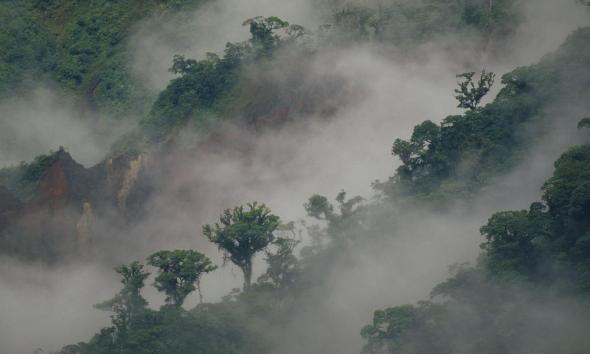
The Tiger species that’s mostly populated to Asia now lives in dense forestry and high grass lands pictured above. Sadly this is under threat with over twelve x football sized pitched sized forests felled a day the Tiger stands no chance. Human and species conflict is common because of this, regrettably the Tiger pays with it’s life which is a sad yet common fact of life that humans around the world are playing a part in with many not even knowing what their habits are causing..
Common knowledge now states the industry cannot keep up with the high demand for “recyclable products”, so to stay with the demand the logging industry then uses more “worked” land over again to non-worked agricultural land.
Commercialisation and massive want for more “recyclable goods” because we believe that we are doing the correct thing by purchasing only recyclable products has then the knock on effect as it would with the non-recyclable industry.
The three R’s is what we at International Animal Rescue Foundation © “promotes” wisely of which one cannot just practice one, and not the other two, by simply using the “recyclable” option and not concentrating on the other two most important factors then this will push the demand up equalling more deforestation. With illegal logging also on the increase then the circle of destruction spirals out of control.
Pollution is also a massive benefactor that is decreasing Tiger populations due to green land forest destruction that equals lowered birth rates, and eventual death. It’s been widely discussed now within our news journal and many other environmental columns that pollution is at a massive high which again is due to over commercialisation and demand. But how does pollution affect the Tiger species?
Air pollution does not only damage the air it also damages living environments on the Earth’s surface and their inhabitants. Plants and animals are harmed by air pollution. Sometimes it is the pollutants themselves that cause damage. Other times pollutants combine and change the resources that plants and animals depend upon such as water, soil, and nutrients. What types of pollutants are damaging this sector that the Tiger lives within though?
Air pollutants called chlorofluorocarbons (or CFCs) destroy ozone molecules in the stratosphere. This has left places in the layer where the ozone is thin. These areas of thin ozone are called ozone holes. The ozone layer, located in the stratosphere layer of Earth’s atmosphere, shields our planet from the Sun’s ultraviolet radiation.
Ultraviolet radiation causes skin cancer and damages plants and wildlife. In recent decades the number of CFCs released into the atmosphere has decreased significantly due to an agreement between the nations of the world called the Montreal Protocol.
Although it takes a long time to see the impact, the ozone holes might someday be smaller. CFCs cause massive damage to the earths wildlife population as of climate change deterioration, damage to tree’s and lower canopy green forestry land that the Tigers desired “prey” rely on which then forces the Tiger to move on mostly to human populated areas thus causing human species conflict. The Tigers prey I have listed below within the few paragraphs on pollutants.
Sumatran and Bengal Tigers are regularly caught in snares and traps set by company paid locals to keep their workers safe that feed the American and European market with pulp, paper, palm oil and wood.
Tropospheric ozone harms living life forms, Ozone molecules in the troposphere damage lung tissues of animals and prevents plant respiration by blocking the openings in leaves, called stomata, where respiration occurs. Tropospheric ozone harms the plants that the prey of the Tiger feeds on thus decreasing again food intake, lack of sufficient prey food intake then kills or forces the animals out of their natural habitat.
Acid rain kills trees and harms animals to heavy industrialised acidic rain that is high in industrialised areas of the forests destroys the leaves of plants and trees without a doubt. When acid rain soaks into the ground, it can make the soil unhealthy for many living species including the Tiger species and its prey. Acid rain also changes the water in lakes and streams, harming fish and other aquatic life.
The short hand documentary shows what we have al known in the environmental world for many years, what is most concerning though is that there are more Tigers in American homes then there are “in the wild” at a rate of over 10,000 (estimate) The tropical pet trade must END now.
The Tiger species has a preference when hunting of which it hunts the Llamas a “type” Equine species however (not Equine related) that has more or less the same skeleton structure but very poor manoeuvrability in the dense jungles hence why the Tiger hunts the Ungulate species that’s relatively easily hunted that can keep a family of mother and cubs living for up to 3-4 days due to high contents of meat and meat saturation fat levels from the Llamas.
The Llamas feed on mainly grass, shrubs, and lichens. Lichens are earth’s first moss plants that grow on rocks and wood. Llamas are herbivores, so pollutants are a very big problem when they are destroying the Tigers natural habitat meaning its hunting grounds. The Tiger then has reduced prey as the Llamas are forced to move on to fresh pastures green which the Tiger cannot as living in such open areas that the Ungulates species can thrive in makes the Tiger more noticeable to its prey thus reducing natural predatory hunting.
Wild boar, buffalo, water buffalo, primates, hares, antelope and specie deer’s plus many more species that the Tiger “species” also hunt can and are effected by pollutants thus displacing the Tiger and it’s prey so yes indeed pollutants are a very big problem along with deforestation, and the humans massive demand for more “recyclable” products of which there is very little reusing and reducing evident in the modern world that we must ALL now start taking notice off.
Reported in this week’s weekend Leader 17th January 2013 and by WWF (World Wild Fund for nature) poaching of the Tiger species was said to have decreased, which is good news, or is it?
Sumatran and Bengal Tiger populations have decreased so dramatically that poachers simply cannot locate these beautiful kings of the jungle anymore which is good but sad news.
Taking a brief look into figures here and history we can see an awfully shocking trend that one must “not” just blame as quoted on the poacher. We all have to except the blame as explained above regarding pollutants, over commercialisation and obsessive consumerism.
The tiger population dropped over the past 100 years from an estimated 100,000 in the 1900’s to only 4000 in the 1970’s. A concerted effort by wildlife protection groups in the 1970’s halted their rapid demise and the global population of tigers in the wild has grown modestly to around 6000 at the turn of the century with great thanks to then Indian Prime minster that launched a massive operation to cease hunting that was being fronted by the illegal poaching industry, everyone breathed a sigh of relief as the Tiger population then shot back up which hadn’t the Indian president taken action then all Indian native Tigers would have been lost.
Poaching continues to this day though all over Asia and Russia, however. When a Russian poacher can make as much from a single tiger kill as he would normally earn in 6 years, it will take more than words to halt this tragedy it takes “skill and going back to our grass roots to understanding the Tiger and it’s preys natural habitat”. Only then can one preserve the Tiger species.
The range of tigers has changed over the past 100 years. Once roaming all throughout India, Southeast Asia they now only small live in pockets of small natural habitat. Law enforcement has not lowered poaching it’s unfortunately the massive declines in numbers of the Tiger species.
Quote
“In the 1970’s we came dangerously close to losing forever one of the world most magnificent creatures. Poaching, deforestation, and human expansion to pollution brought all species of tiger to the brink of extinction. Indeed, over the past centuries, 3 of the 8 sub-species that existed became extinct the Caspian, Javan and Balinese tigers. Today, we are by no means out of the woods. All remaining sub-species of tiger are endangered, making the tiger species as a whole nearly extinct”
The news report of which I have copied below from the Weekend leader wrote 17th January, quote;
In cheering news for wildlife conservationists, tiger poaching dropped nearly 60 per cent in 2011 as compared to the previous year, though it continues to pose a major threat to the survival of the big cat in the country, a leading NGO said. According to the Wildlife Protection Society of India (WPSI), 13 tigers were hunted last year as compared to 30 in 2010 - a decline of 57 per cent. The bodies of poached tigers, seized bones and skins were computed to arrive at the figures.
Adding other factors like road accidents, infighting, fighting with other animals, electrocution, found dead, and rescue and treatment, the overall toll rises to 61. In 2010, it was 58. However, top on the list of WPSI’s tiger mortality is the found dead figure, 21.
The toll from infighting was the same as that of poaching. In the previous year, 10 tigers died in such fights. “There has been definitely a decrease in poaching cases in 2011 compared to 2010, but it does not mean poaching has stopped,” said WPSI’s Tito Joseph. This could be “due to effective patrolling strategies adopted by the tiger authority (National Tiger Conservation Authority) in coordination with other agencies,” Joseph said. The illegal wildlife trade continues to be a major threat to tigers. Joseph said traders were offering huge amounts of money in black markets for tiger body parts.
“Recently trade activities were detected in Vietnam and Cambodia. The threat is not only from China (a known hub for such trade) but also from Southeast Asian countries,” he said. “We need to be vigilant 24 hours 365 days,” Joseph said. “Wildlife articles always have a very premium market and prices are not going to come down easily,” says U.C. Tiwari, wildlife warden of the Corbett National Park, Uttarakhand. The 1,200-plus sq km Corbett sanctuary is one of the 39 tiger reserves in the country.
The poaching figure only reflects the cases that come to light and it may not truly reflect the ground condition, said Tiwari. He warned that the situation could turn alarming if the mortality rate of adult tigers rises. “Because adult tigers don’t die easily… there has to be some extraordinary circumstance.” According to WPSI, of the 21 tigers found dead in 2011 many were adult tigers. In 2010, 15 tigers were found dead.
“The fact that many poachers are now lodged in jails has surely contributed to the decrease. They are still cooling their heels in different jails,” the official added. Acknowledging this, Ashok Kumar, an eminent tiger conservationist and vice chairman of the NGO Wildlife Trust of India, said poaching has reduced considerably as many poachers were jailed. “Our lawyers fight against them in court so they do not come out of jails.
“All Alwar (Rajasthan)-based poachers are today in jails,” said Kumar, referring to a gang blamed for extermination of tigers in the Sariska reserve, one of the two tiger sanctuaries in the state.
Kumar has been at the forefront of the fight against poachers and illegal trade of wildlife for over two decades. He was the first director of Traffic India, which studies wildlife trade.
Rajasthan is also home to the famed Ranthambore National Park. Sariska currently has five tigers, all shifted from Ranthambore as part of a government attempt to repopulate tigers in the reserve. The latest official tiger census report released in March 2011 estimated about 1,700 tigers in the country. – IANS
Reports for 2012 show other alarming figures though that pinpoint to “exactly what we have been informing the DEA South Africa of and India too” please read the link http://www.guardian.co.uk/environment/2012/aug/20/tiger-population-india-tourism-ban
The Rhinoceros in South Africa when we International Animal Rescue Foundation © started Operation Trojan Horse proved that “tourists where being watched to even “poachers” joining the damn tourists with no one law authority even aware of this.
These alarming finds were sent immediately to the DEA (Department of Environmental Affairs) South Africa and tour guides informing them to keep check of who is actually on their safari tour guides to entering South Africa.
India would ONLY do this IF they knew that poachers where becoming even more brazenly operational and daring by acting as tourists, then giving pin point geographical locations of Rhinoceros crashes hence we now believe 100% with evidence that we have, that the poacher is undertaking the same methods of infiltrating the South African tourists mobile travel safaris in South Africa as they are now in India.
We don’t believe that the poaching has decreased at all because of arrests made and increased patrols we believe that poaching has decreased simply because there are very few Tigers within the wild of which the Bengal and the Sumatran are the sought after Tigers. In an extracted article the following was quoted http://www.wtop.com/41/2968728/World-tiger-population-approaching-possible-extinction
Badaling Safari World - Beijing sell Tiger Bone within the zoo. It’s illegal hence why the permit states dispose of the bones and skin discretely so the government “know this” yet couldn’t care less.The investigation back from 2007-2008 by the EIA clearly shows the laws being broken. The Tigers do not die naturally they are staved to death hence why the large import and export of this illegal liquor, Some Tigers are kept back of which they are force breed. http://youtu.be/Rwv8mCw8JJs
“There are only 500 to 600 Sumatran tigers left in the world, so they hope to breed Kavi with one of the zoo’s youngest females. The zoo only has three Sumatran tigers right now.
In August of 2012 there was an exact number of one thousand Sumatran Tigers Panthera tigris sumatrae so since August and January 2013 “someone is not giving the correct figures out” We knew there was only 1000 left in the wild as of Greenpeace’s investigations into the Ramin tree, palm oil and pulp and paper trade.
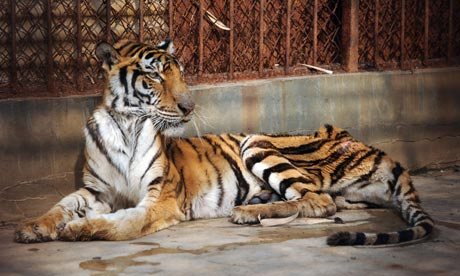
On checking the full story in this zoo it was horrifying, these are protected and endangered species and this is how we treat them. The world has gone insane and sadly there are more zoos in Asia just like this.
With regards to the Bengal Tiger Panthera tigris there are literally 2,500 in the wild to date. The total number of Tigers in the wild that does not include the Siberian equals 3000 to 3100. The Siberian Tiger that’s critically endangered numbers at what some conservationists have quoted without taking into account scientific analysis is 500 – 600 however this is untrue.
Approximately 500 Amur tigers actually survive in the wild, but the effective population is a measure of the genetic diversity of the world’s largest cat. Very low diversity means any vulnerability to disease or rare genetic disorders are likely to be passed on to the next generation. So these results paint a grim picture for the tiger’s chance of survival.
“The findings are reported in the journal Mammalian Biology”
The Amur tiger, or Siberian tiger as it is also known, once lived across a large portion of northern China, the Korean peninsula, and the southernmost regions of eastern Russia. During the early 20th Century, the Amur tiger was almost driven to extinction, as expanding human settlements, habitat loss and poaching wiped out this biggest of cats from over 90% of its range.
By the 1940s, just 20 to 30 individuals survived in the wild. The new study has identified that this recent “genetic bottleneck” - when the breeding population of tigers was so critically low - has decimated the Amur tiger gene pool.
A more genetically diverse population of animals has a much better chance of survival; it is more likely, for example, to contain the genetic resistance to a variety of diseases and less likely to succumb to rare genetic disorders, which can be “cancelled out” by healthy genes.
Scientists in Russia, Spain and Germany worked together to analyse DNA samples from 15 wild Amur tigers in the Russian Far East. They took blood samples from the animals and screened them for certain “markers” - points in the DNA code that show that an animal had parents that were genetically very different from each other.
The results revealed evidence of the genetic bottleneck during the tigers’ recent history, when the variety of genes is being passed on dramatically reduced. Genetically speaking, the Amur tiger has not recovered from this. “Our results are the first to demonstrate a quite recent genetic bottleneck in Siberian tigers, a result that matches the well-documented severe demographic decline of the Siberian tiger population in the 1940s,” the researchers wrote in the paper.
“The worryingly low effective population size challenges the optimism for the recovery of the huge Siberian cat.”
Our total from number count of Tigers from scientific findings, investigations and worldwide knowledge estimates the entire Tiger species to now be under 3.400 and should pollution, obsessive consumerism, increasing commercialisation that increases climate change and impulse purchasing now not reside or drop then the tiger species coupled with poaching “will be extinct in two years or less” and that’s fact, along with that will then follow the Lion, Pangolin and the Rhinoceros species.
Bone wine trade and “skin or fur” trade is also a major benefactor that see’s the Tiger regrettably poached, Tigers are critically endangered and therefore non-tradable, the Asian government know damn well that Tigers are prohibited by International Union for Conservation of Nature laws from being moved or poached, CITES also prohibits such illegal activity of which traders to sellers MUST be shut down, fined and/or prosecuted. Such criminal activity is just ignored though and what part Asia actually play in helping to save any animal after viewing the EIA investigations in to blood ivory is still to be seen.
Be the voice - Help us to shut APP down, they are murderers and environmental desecration experts


